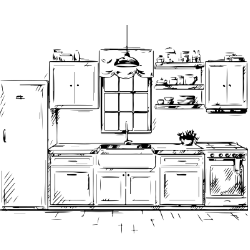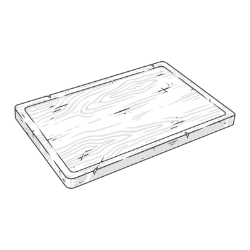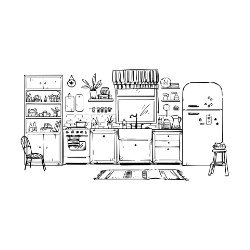
What Color Curtains Go With Gray Walls?

You've probably seen some fantastic interior design ideas on Pinterest or Instagram. Still, now you want to try them yourself. The problem is, you don't really know where to start.
Interior design is a huge part of home decorating.
From choosing paint colors to picking furniture pieces, it takes time and effort to create a space that reflects who you are.
Interior designers spend years learning their craft before they even get started. First, they study architecture, psychology, art history, and other fields to develop a unique style.
Then, they use all of this knowledge to help homeowners select the right colors, textures, and designs for their spaces.
As gray is a neutral color, pretty much any tone will go with it! This is great news for those that love experimenting with colors.
So, how do you become an expert in home decor? The good news is that there isn’t any special training required.
If you enjoy reading about home improvement, you can learn everything you need to know from books and magazines.
You could also attend workshops and classes at museums, libraries, and community centers.
However, suppose you aren’t willing to put in the work. In that case, these tips will help get your dream home decorated without spending thousands of dollars!
1. Start Small
Before diving into significant renovations, make sure you have a clear vision of your long-term goals. Then, choose one room (such as a living room) and focus on making it look great.
Then, when you feel like redecorating another area, you won't have to worry about changing something else first.
2. Use Colors That Match Your Furniture
If you already own furniture, you should always consider the colors used throughout your house.
If you're unsure which direction to take, ask your friends and family members for advice. They might notice patterns or trends you don't see.
For example, if most people in your neighborhood have blue couches, you might choose a similar shade. Or, if everyone has white kitchens, you'll probably purchase cabinets in a similar tone.
3. Look At Old Photos
Taking inspiration from photos taken by your grandparents may seem strange, but it works well in certain situations.
When you view old photos, you'll notice what's happening around the house, such as window treatments and wall coverings.
4. Ask An Expert
If you find that your friend has a knack for creating custom home decor items, ask them to consult on your project.
A professional designer will understand what you need and can provide suggestions based on their experience.
5. Be Creative

There's no set rule regarding how many styles you should incorporate into your home. Some people prefer a minimalist style, while others love mixing bright hues and bold accessories.
It's up to you to decide whether you prefer something simple or complex - just remember that less is more!
6. Decorate Based On Your Mood
If you tend to be happy indoors, pick calming shades to accentuate your mood. In contrast, if you usually feel energetic when you visit friends' houses, try using brighter colors to bring out your personality.
7. Keep Things Simple
It doesn't matter if you live alone or share your home with roommates; the best interior design is easy on the eyes.
Don't overload your rooms with too much stuff; instead, keep things clean and organized, so visitors can quickly identify where things belong.
8. Focus On Space-Saving Techniques
One of the easiest ways to reduce clutter is to remove unnecessary objects. So if you want to keep your closet tidy, simply cut off the bottom portion of each shoe.
This allows them to fit inside the box perfectly, leaving enough space for shoes of varying heights.

9. Consider Lighting Quality
When choosing lighting options, always opt for natural light whenever possible. Incandescent bulbs are inexpensive and offer excellent energy efficiency, but they produce heat.
Fluorescent bulbs are generally less expensive than incandescent ones. They have lower heat levels, but their lifespan is shorter, and they can cost more to replace.
LED lights are yet another option and last longer than fluorescent bulbs, but they cost more initially. However, they also require little maintenance, save money over time, and use 80% less electricity.
10. Create Personalized Storage Solutions
Instead of purchasing new storage solutions every year, consider repurposing existing containers to store everything from extra linens to toys.
You can even create decorative storage compartments to hide small appliances like coffee makers, microwaves, and refrigerators.
11. Use Natural Elements To Enhance Interior Design
Instead of painting every surface in your living room green, invest in an attractive rug.
Natural elements, including wood floors and stone countertops, also help give a room a distinct character.
12. Choose Comfortable Furniture
The right chairs and tables can make or break any room. To avoid buying high-maintenance pieces, look for durable, stain-resistant, and comfortable leather seating and wooden surfaces.
13. Get The Right Fit For Your Room
Choosing the wrong size blinds, flooring, or furniture can ruin a room's appearance.
If you're unsure which items will work well together, consult an expert before making significant purchases.
14. Choose A Theme That Works Well With Your Lifestyle
Some people decorate based on the seasons, while others have fun themes such as "My First Pet" or "Family Vacation."
Deciding ahead of time on a theme that works with your lifestyle will be easier to maintain and add to your collection.
15. Add Artwork And Paintings
Add artwork, paintings, or photographs to make any area stand out.
Whether you choose to hang pictures on the wall or display them as framed art, these personal touches will add drama and interest to any room.
16. Think About How Your Living Room Will Be Used
If you don't plan to entertain guests often, consider adding additional seating elsewhere in your house. Otherwise, think about how your living room will be used most frequently.
Do you spend time watching television or playing video games? Is there a couch, chair, or ottoman you'll need to use regularly?
17. Find An Easy Way Of Adding Decorative Accessories
Finding just one accessory to complete your desired decor scheme may prove difficult. Instead, fill up empty shelves or bins with unique accessories that accentuate the overall style of your room.
They could include vases, candles, plants, books, and other items that draw attention to themselves rather than the actual piece of furniture.
Conclusion
To conclude, if you want to keep costs down and get the best value for your home, you should start by determining whether you really need to upgrade anything or not.





